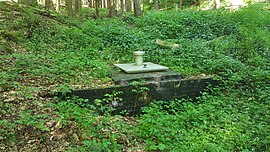Old Hope Pit
| Old hope | |||
|---|---|---|---|
| General information about the mine | |||
| Mining technology | Civil engineering | ||
| Rare minerals | Malachite , azurite , copper gravel | ||
| Information about the mining company | |||
| Start of operation | 1730 | ||
| End of operation | after World War I | ||
| Funded raw materials | |||
| Degradation of | copper | ||
| Geographical location | |||
| Coordinates | 50 ° 43 '15.3 " N , 8 ° 12' 5.2" E | ||
|
|||
| Location | Langenaubach | ||
| local community | Haiger | ||
| country | State of Hesse | ||
| Country | Germany | ||
| District | Dillenburg mountain area | ||
The Old Hope mine was a copper mine near Langenaubach ( Haiger municipality ) in the Lahn-Dill district .
Aisle means
The vein of the mine is part of a copper vein line that extended from above Langenaubach via Donsbach and Nanzenbach to Hirzenhain . The pits on this passage train were:
- Old hope near Langenaubach
- Bar scales , mine luck for miners , God's grace near Donsbach
- Rose garden at Sechshelden
- Nicolaus and Fortunatus near Dillenburg
- Alte Lohrbach, Neuermuth, common colliery near Nanzenbach
The old hope mine was built on two ore veins. On the späthigen, trending in the seventh hour north incident transitional Old Hope transition and the quartzose and powerful to 3 "Lembachsgang which occurred underlined and the East in the 11th hour. In 1867 there were 110 laughers on the first course and around 90 laughers on the last. The salmon salmon walk was known for a length of 300 laughs and raised to 50 laughs on the upper level.
history
The pit was between Langenaubach and Donsbach in the upper Selmbach valley. Copper was mined from at least 1730 onwards. Becher describes that the vein on which this pit was built consisted of ore nests that could be easily excavated. The construction of the deep tunnel is said to have been done in extra, which means that the costs were not covered. The old hope , located in the upper Selmbach valley, was consolidated before 1789 with the pit “Blessed Hope” located deeper in the Lehmbachtal (at that time also called Die Lembach ). A theft in September 1778 is reported in the Dillenburg Intelligence News .

In 1867 Odernheimer reported that at that time the mine had been out of service for a long time. The deep tunnel had a length of 140 pools (1 pool = approx. 2 m) and a depth of 12 pools. In 1867 he was driven 100 laughs into the mountain and was supposed to cut the vein at 120 laughs. The depth at this length of tunnel would be 40 peaks. At this point only the deep Lembach tunnel of the former 5 tunnels should have been open.
At Odernheimer, the deep lembach tunnel is probably the deep tunnel of the Blessed Hope pit . There is no other explanation for the notice that has been out of service for a long time together with the reference that the deep tunnel has to be driven further and is open. In addition to the vein name Lembachsgang , which characterizes the vein of the Gesegnete Hoffnung mine, the fact that Odernheimer states that mining began in 1737, which, however, corresponds to the earliest documented start of mining for the Gesegnete Hoffnung mine. Confusion in the descriptions due to the consolidation that has taken place seems obvious.
Ernst Frohwein reported in 1885 that the 350 m long exposed, up to 1 m thick Altehoffnungsgang, in the bottom of the gallery at a depth of 40 m, was mined to the extent that it was ore-bearing. It is reported that the Lembach dike, which is also up to 1 m thick, is exposed over a length of 350 m in the aforementioned tunnel floor and that it was excavated to a depth of 70 m underground to a length of 50 m by means of a die (blind shaft), where this passage joins the Altehoffnungsgang schaart. He also writes that a similar corridor touches down 600 m to the northwest, which seems to be the continuation of the Lembach corridor. This was crossed to 100 m and has so far been dismantled to a depth of 20 m.
Operation was suspended in the 19th century and resumed in the 20th century. How far the tunnels were driven in the 20th century is unknown to the author. After the First World War, the mine was permanently shut down. Today the (deep) tunnel or shaft cover of the Blessed Hope pit can still be seen , as well as a larger spoil dump on which copper pebbles can be found.
See also
Individual evidence
- ↑ Mineral Atlas : Old Hope Pit
- ↑ Historical working group Haiger and his room e. V .: Haigerer Geschichtsblätter: Issue 51 . Haiger May 2008.
- ^ A b Johann Philipp Becher: Mineralogical description of the Oranien-Nassauische Lande: together with a history of the Siegen smelting and hammering industry . 1789.
- ↑ a b F. Odernheimer: The mining and metallurgical industry in the Duchy of Nassau: statist. News, geognost., Mineralog. u. techn. Descriptions d. Deposits of usable minerals, d. Mining u. Ironworks . tape 1 . CW Kreidels, Wiesbaden 1867.
- ^ Dillenburg Intelligence News of the year 1778

